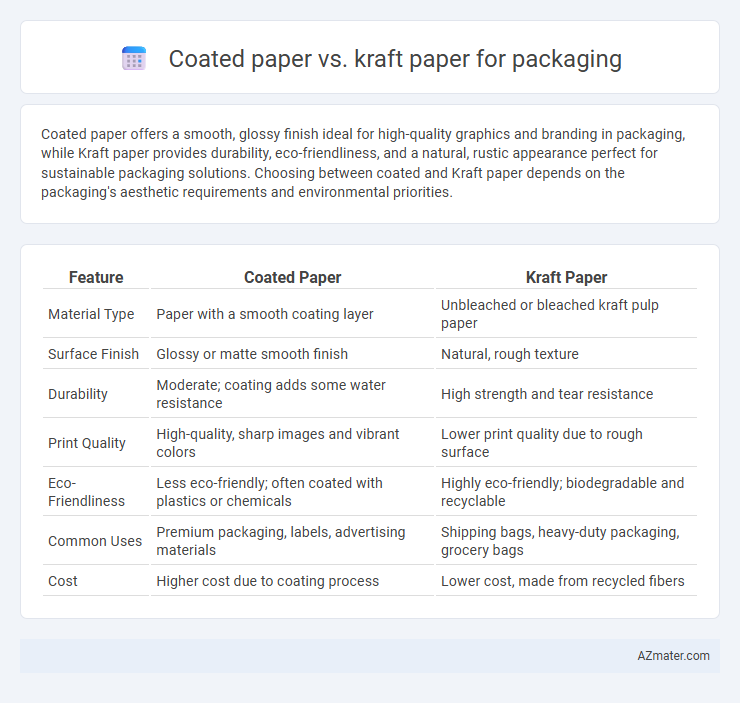Coated paper offers a smooth, glossy finish ideal for high-quality graphics and branding in packaging, while Kraft paper provides durability, eco-friendliness, and a natural, rustic appearance perfect for sustainable packaging solutions. Choosing between coated and Kraft paper depends on the packaging's aesthetic requirements and environmental priorities.
Table of Comparison
| Feature | Coated Paper | Kraft Paper |
|---|---|---|
| Material Type | Paper with a smooth coating layer | Unbleached or bleached kraft pulp paper |
| Surface Finish | Glossy or matte smooth finish | Natural, rough texture |
| Durability | Moderate; coating adds some water resistance | High strength and tear resistance |
| Print Quality | High-quality, sharp images and vibrant colors | Lower print quality due to rough surface |
| Eco-Friendliness | Less eco-friendly; often coated with plastics or chemicals | Highly eco-friendly; biodegradable and recyclable |
| Common Uses | Premium packaging, labels, advertising materials | Shipping bags, heavy-duty packaging, grocery bags |
| Cost | Higher cost due to coating process | Lower cost, made from recycled fibers |
Introduction to Coated Paper and Kraft Paper
Coated paper features a smooth surface with a layer of clay or polymer, enhancing print quality and resistance to moisture, making it ideal for high-end packaging requiring vibrant graphics. Kraft paper, made from chemical pulp, is durable, biodegradable, and has a natural brown appearance, commonly used for eco-friendly packaging and heavy-duty applications. Both materials serve distinct roles in packaging, balancing aesthetic appeal and environmental considerations.
Key Differences Between Coated and Kraft Paper
Coated paper features a smooth surface with a layer of clay or polymer that enhances printing quality and provides water resistance, making it ideal for high-end packaging with vibrant graphics. Kraft paper is uncoated, known for its strength, durability, and eco-friendliness, commonly used for heavy-duty packaging and products requiring natural aesthetics or recyclability. The key differences lie in their finish, printability, moisture resistance, and environmental impact, with coated paper prioritizing visual appeal and kraft paper emphasizing strength and sustainability.
Physical Properties and Appearance
Coated paper features a smooth, glossy surface due to a clay or polymer coating, enhancing print quality and providing moisture resistance, suitable for high-end packaging. Kraft paper is uncoated, coarse, and brown, known for its strength, rigidity, and tear resistance, making it ideal for durable, eco-friendly packaging. The physical properties of coated paper favor aesthetic appeal and print clarity, while kraft paper excels in durability and natural texture.
Printability and Surface Finish
Coated paper offers superior printability and a smooth, glossy surface finish that enhances color vibrancy and sharpness, making it ideal for high-quality packaging designs. Kraft paper features a rougher texture and uncoated surface, resulting in limited print quality but providing a natural, rustic appearance favored for eco-friendly packaging. The choice between coated and kraft paper depends on whether visual appeal or environmental sustainability is prioritized in packaging applications.
Strength and Durability Comparison
Coated paper offers a smooth surface with enhanced print quality but generally lacks the tensile strength and tear resistance found in kraft paper, which is made from long fibers and provides superior durability for heavy-duty packaging. Kraft paper's robust fiber composition makes it more resistant to moisture and physical damage, making it ideal for protective packaging applications. While coated paper excels in aesthetics and moisture resistance due to its surface treatment, kraft paper remains the preferred choice for strength-intensive packaging needs.
Environmental Impact and Sustainability
Coated paper, typically made with a plastic or clay surface layer, offers excellent print quality and barrier properties but poses challenges in recycling due to its non-biodegradable coatings and higher energy consumption during manufacturing. Kraft paper, known for its natural brown color and durability, is produced from unbleached wood pulp and is fully biodegradable and widely recyclable, making it a preferred sustainable choice for eco-friendly packaging. Using kraft paper significantly reduces environmental impact through lower carbon emissions and enhanced compostability compared to coated paper alternatives.
Cost Considerations for Packaging
Coated paper offers a smooth finish and high print quality but comes at a higher cost due to additional processing and materials used, making it less ideal for budget-sensitive packaging projects. Kraft paper is more cost-effective, providing durability and strength with natural fibers at a lower price point, which benefits businesses prioritizing affordability over aesthetics. Selecting packaging material depends on balancing the higher expense of coated paper with its premium appearance against the economic and functional advantages of kraft paper.
Common Packaging Applications
Coated paper is commonly used in packaging applications requiring high-quality printing, such as in cosmetic boxes, food packaging, and gift wraps, due to its smooth surface and excellent ink receptivity. Kraft paper is favored for heavy-duty packaging like shipping bags, grocery bags, and industrial wrapping, valued for its strength, durability, and eco-friendly properties. Both materials serve distinct roles in packaging, with coated paper offering aesthetic appeal and kraft paper emphasizing robustness and sustainability.
Choosing the Right Paper for Your Product
Choosing the right paper for packaging depends on your product's protection and aesthetic needs; coated paper offers a smooth, glossy finish ideal for high-quality printing and vibrant graphics, enhancing brand appeal. Kraft paper provides superior strength and durability with a natural, rustic look, making it perfect for heavy-duty packaging and eco-friendly branding. Assess the product weight, required moisture resistance, and desired visual impact to determine whether coated or kraft paper best meets your packaging goals.
Conclusion: Which Paper is Best for Your Packaging Needs?
Coated paper offers a smooth surface ideal for high-quality printing and vibrant graphics, making it best for premium packaging that demands visual appeal. Kraft paper provides superior strength, durability, and eco-friendliness, suited for heavy-duty and sustainable packaging solutions. Choosing between coated and kraft paper depends on whether your priority is aesthetic presentation or durability and environmental impact in your packaging needs.

Infographic: Coated paper vs Kraft paper for Packaging
 azmater.com
azmater.com